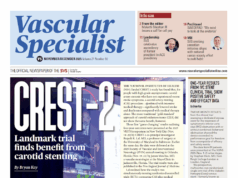
High stroke and death rates relating to carotid stenting in the Pacific Northwest may be driven by the selection of high-risk patients with less than 80% stenosis, and reducing the frequency of stenting in this high-risk group—along with better adherence to guideline-recommended medical management—could improve regional outcomes.
This was among the key concluding messages delivered by Rahul Ghosh (Texas A&M University, Houston, USA) during one of the 2024 Vascular Annual Meeting (VAM; June 19–22, Chicago, USA) Vascular and Endovascular Surgery Society (VESS) Scientific Sessions as he presented findings from a retrospective review of asymptomatic carotid stenosis patients in the Pacific Northwest region undergoing transcarotid artery revascularisation (TCAR) and transfemoral carotid artery stenting (TF-CAS), within the Vascular Quality Initiative (VQI), from 2016 to 2022. The research was conducted at the University of Washington in Seattle, USA, and led by senior author Sara L Zettervall.
“Education and awareness are critical for improving care,” said Ghosh, a final-year MD/PhD student at Texas A&M University, speaking to Vascular News in light of these findings. “By leveraging registry data to analyze real-world outcomes, surgeons can gain a clearer understanding of how practice patterns affect quality, enabling more informed decisions about when to intervene in asymptomatic patients—particularly those with significant comorbidities.”
Ghosh reported that 1,154 asymptomatic patients across 27 centres underwent carotid stenting in the Pacific Northwest from 2016 to 2022, of which 77% received TCAR and 23% received TF-CAS. The overall stroke/death rates were roughly 3% for both TCAR and TF-CAS, with centre-specific rates ranging from 0–6% for TCAR and 0–17% for TF-CAS. Researchers also found that centres with higher stroke/death rates generally treated fewer patients with >80% stenosis, as well as more patients with high-risk anatomy or physiology.
Following Ghosh’s presentation, Jordan R Stern, associate professor of surgery at Weill Cornell Medical College in New York, USA, commented that another of the study’s findings—that being the fact that all centres with stroke/death rates above 3% ranked among the top half of centres for TCAR and TF-CAS volumes in asymptomatic patients—suggests something of a “counterintuitive relationship” between case volume and stroke risk.
“We know from a myriad of literature […] that higher volume generally leads to better outcomes; what’s your explanation for that?” Stern asked the presenter.
Ghosh conceded that, with this having been an observational study, it is difficult to draw conclusions on any causal relationship, or whether volumes “play into” the high stroke/death rate.
“Of course, patient selection is a big thing,” he added. “The centres with the high stroke and death rates—you could also say they are getting the sicker patients so, maybe, their outcomes are worse [because of that]. Regardless, the association is there, and the important thing is to get the information out there and consider looking more carefully at this high-risk population, and whether an intervention provides a good risk-benefit for them or not.”












